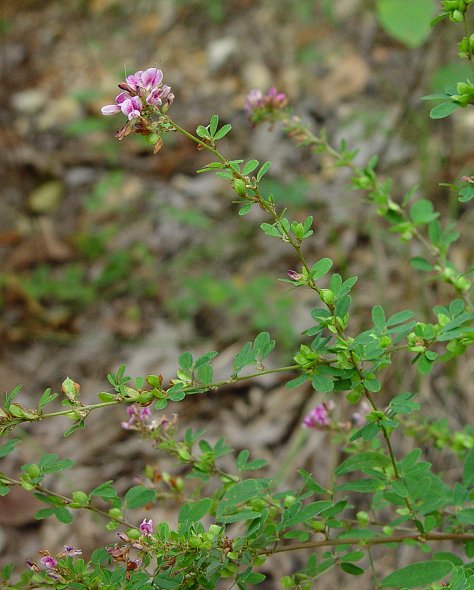Lespedeza virginica (L.) Britton
Slender Bush Clover

Native
CC = 5
CW = 5
MOC = 79
© DETenaglia
Lespedeza virginica (L.) BrittonSlender Bush Clover | |
 |
Native CC = 5 CW = 5 MOC = 79 |
© DETenaglia |
|
Family - Fabaceae/Faboideae Habit - Perennial forb from a woody caudex. Stems - Ascending to erect, to 80 cm, 1-3 mm in diameter near the base, usually branched only above the midpoint, longitudinallly ridged, sparsely to densely pubescent with loosely appressed to more or less spreading hairs, sometimes glabrous or nearly so toward the base.
Leaves - Alternate, trifoliate, stipulate, petiolate. Petioles usually long and slender, 5-13 mm long, 0.2-0.5 mm wide, sparsely to moderately appressed-hairy. Stipules 2-4 mm long, linear to hairlike. Leaflets 9-30 mm long, 3-9 mm wide, linear to narrowly oblong, those of the lower leaves rarely narrowly elliptic, rounded to angled at the base, rounded to nearly truncate or bluntly pointed at the tip, the midvein usually extended as a minute, sharp point at the very tip, the upper surface glabrous or sparsely appressed-hairy near the midvein, the undersurface moderately to densely appressed-hairy. Lateral veins forming closed loops near the leaflet margins. Axillary leaves often well developed at most nodes.
Inflorescence - Short, dense racemes or clusters from upper and median leaf axils, unbranched, shorter than or only slightly exceeding the leaves, with mostly 4-10 flowers per cluster, the axis not hidden by the flowers. Inflorescence divisions subtended by pair of needle-like bracts resembling the stipules of the leaves. Pedicels to 1.5mm long, antrorse-pubescent.
Flowers - Calyces with the tube 1.0-1.5 mm long, the lobes 2.0-2.5 mm long. Corollas papilionaceous, 5-7 mm long, pinkish purple to light pinkish purple, the banner to 4mm broad, usually with dark purple markings toward the base, the keel sometimes darker purple at the tip, distinctly shorter than the wings. Stamens diadelphous, white, glabrous. Anthers yellow. Ovary green, pubescent. Style upcurved at the apex, pubescent, to 3 mm long in flower.
Fruits - Flattened, 1-seeded legumes, those from open flowers 5-6 mm long (including the stalk), the calyx covering about the lower 1/3-1/2; those from cleistogamous flowers 4-6 mm long, the calyx covering the lower 1/5-1/4. Seeds 2.5-3.0 mm long, olive green to brown.
Flowering - May - September. Habitat - Upland prairies, sand prairies, glades, upland forests, tops of bluffs, streambanks, fencerows, pastures, old fields, quarries, railroads, roadsides. Origin - Native to the U.S. Lookalikes - L. violacea. Other info. - This common species can be found throughout most of Missouri, with the apparent exception of the northwestern corner of the state. It also occurs across most of the eastern half of the U.S. It can be identified by its leaves, which are 3 times longer than broad and pubescent on both surfaces, and its compact flowering clusters. The lateral venation in the leaves is looping rather than herringbone-like, serving as a reliable character to differentiate this plant from the invasive sericea lespedeza. Another species, L. violacea, appears very similar but has leaves which are either glabrous or, more commonly, only pubescent on the midrib and the leaf tissue within 1-2 mm of the midrib. The two species can sometimes be found growing in close proximity. L. virginica is beneficial to wildlife and livestock, which browse upon the plant and consume its seeds. The plant is known to hybridize with several other native species of Lespedeza. Photographs taken at the Peck Ranch Wildlife Refuge, Carter County, MO., 7-19-01 (DETenaglia); also at Victoria Glade, Jefferson County, MO, 8-30-2015, Little Lost Creek Conservation Area, Warren County, MO, 10-10-2020, and Don Robinson State Park, Jefferson County, MO, 7-13-2022 (SRTurner). |